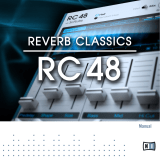
1.2 Reading conventions
Designation of supported hardware and software
The SSL X-Verb Plug-In software only runs on SSL DUENDE Units that have been upgraded to the DUENDE V3 Firmware/Drivers.
The functionality of the different DUENDE Models is largely similar although their detailed specifications may vary, especially
the optional V3 Slot Extensions which allow a different number of X-Verb instances to be used at the same time.
The information in this manual relates to all Slot and Multi DUENDE configurations. Differences are pointed out where
necessary.
Key commands and key combinations
Some functions of the SSL X-Verb may be accessed through the use of computer keyboard keys or key combinations, as well as
by using a mouse or other input device. In this manual computer keys will be shown between square brackets. For example,
the key for the letter "E" will be written: [E]. Key combinations will be written using "+" signs. For example, pressing the "D" key
while holding the "Control" key will be written as [Ctrl]+[D].
Menus
Where appropriate, to indicate a "path" under one of the main software menus, the following format will be used:
menu: Header|Submenu 1|Submenu 2|Submenu 3|Item.
Screen shots
The appearance of the SSL X-Verb on your computer screen may be different from the screen shots in this manual. This could be
because your SSL hardware configuration is different, because you are using a different version of of the Operating System,
because you are using different OS display settings, or because the look of the SSL X-Verb might have slightly changed.
1.3 Safety and Installation Considerations
This section contains definitions, warnings, and practical information to ensure a safe working environment. Please take time
to read this section before installing or using this unit. Please do not dispose of these instructions.
General Safety
•
Read these instructions.
•
Keep these instructions.
•
Heed all warnings.
•
Follow all instructions.
•
Do not use this apparatus near water.
•
Do not expose this apparatus to rain or moisture.
•
Do not block any ventilation openings. Install in
accordance with the manufacturer’s instructions.
•
Do not install near any heat sources such as radiators,
heat registers, stoves or other apparatus (including
amplifiers) that produce heat.
•
There are no user-adjustments, or user-serviceable items,
on this apparatus.
•
Adjustments or alterations to this apparatus may affect
the performance such that safety and/or international
compliance standards may no longer be met.
Caution
•
To reduce the risk of electric shock, do not perform any
servicing other than that contained in these Installation
Instructions unless you are qualified to do so. Refer all
servicing to qualified service personnel.
Installation Notes
•
When installing this apparatus, place the host system
into which it is to be installed on a secure level surface.
•
To prevent damage from static electricity when installing
this apparatus, either to the host system or to this
apparatus, always take proper anti-static precautions.
Always use an anti-static wristband. If in doubt, please
refer to qualified service personnel.
•
Take care of rough or sharp edges when accessing the
inside of the host system.
•
Never install or remove this apparatus whilst the host
system is powered. Always remove the power cord from
the host system prior to accessing this apparatus.
•
If in doubt about installing this apparatus, please refer to
qualified service personnel.
Page 4






















